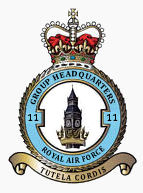No. 11 Group RAF
| No. 11 Group RAF | |
|---|---|

No. 11 Group badge depicting the clock tower of the Palace of Westminster surrounded by the astral crown
|
|
| Active | 1 Apr 1918 – 17 May 1918 22 Aug 1918 – May 1920 1 May 1936 – 31 Dec 1960 1 Jan 1961 – 1 Apr 1963 1 Apr 1968 – 1 Apr 1996 |
| Country | United Kingdom |
| Branch | Royal Air Force |
| Type | Group Headquarters |
| Role | Defence of London & South East England, Fighter Offensive |
| Part of | RAF Fighter Command |
| Garrison/HQ |
RAF Uxbridge, Middlesex, England (1918–1968) RAF Bentley Priory, Middlesex, England (1968–1996) |
| Motto(s) | Tutela Cordis (Latin: Defence of the heart) |
| Royal Air Force Ensign |  |
| Commanders | |
| Notable commanders |
Air Vice-Marshal K R Park |
RAF Uxbridge, Middlesex, England (1918–1968)
No. 11 Group was a group in the Royal Air Force for various periods in the 20th century, finally disbanding in 1996. Its most famous service was during 1940 when it defended London and the south-east against the attacks of the Luftwaffe during the Battle of Britain.
No. 11 Group was first formed on 1 April 1918 in No. 2 Area as No. 11 (Equipment) Group, and was transferred to South-Western Area the next month on 8 May. 11 Group's short first existence came to an end on 17 May 1918, when it was disbanded.
The next incarnation of the Group was later the same year when it was formed in North-Western Area on 22 August. On 6 February 1920 Group Captain I M Bonham-Carter took command. Three months later, in May 1920, No. 11 Group was reduced to No. 11 Wing.
It was reformed on 1 May 1936 as No. 11 (Fighter) Group by renaming Fighting Area. On 14 July 1936, 11 Group became the first RAF Fighter Command group formed, with the responsibility for the air defence of southern England, including London.
11 Group was organised using the Dowding System of fighter control. Group Headquarters was at Hillingdon House within RAF Uxbridge. The Group operations room was underground in what is now known as the Battle of Britain Bunker. Commands were passed to the sector airfields, each of which was in charge of several airfields and fighter squadrons. The sector airfields were:
11 Group's most famous period was during the Battle of Britain when, due to its position, 11 Group bore the brunt of the German aerial assault. Pilots posted to squadrons in 11 Group knew that they would be sent into certain action while pilots and squadrons transferring out of 11 Group knew that they were going to comparatively safer duty.
...
Wikipedia
